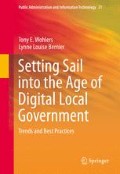Abstract
Though the Internet emerged as a popular medium during the 1990s and both the private and, to some extent, public sector embraced it as a new means to disseminate information, the federal government did not establish its official e-government strategy until Mark Forman was appointed Federal Chief Information Officer (CIO) in the early 2000s. On July 1, 2001, the Office of Management and Budget (OMB) formed the E-Government Task Force aimed at “improving the quality of services to citizens, businesses, governments and government employees, as well as the effectiveness and efficiency of the federal government” (United States of America & Executive Office of the President, 2002).
References
City of Seattle. (1996). How the city handles technology: A strategic agenda. Washington, DC: City of Seattle.
City of Seattle. (1997). PANPLAN. A strategic vision for the City of Seattle Public Access Network. Washington, DC: City of Seattle.
City of Seattle. (2000). 2000 adopted budget. Planning for a new millennium. Washington, DC: City of Seattle.
City of Seattle. (2001). New elements of democracy. Recommendations of the Seattle Commission on Electronic Communication. Washington, DC: City of Seattle.
City of Seattle. (2002). Proposed consolidation of the Department of Technology with the Department of Executive Administration. Washington, DC: City of Seattle.
City of Seattle. (2009). News release. Councilmember Harrell announces technology initiatives for 2010. Washington, DC: City of Seattle.
City of Seattle. (2010). New website opens city data to the public. Washington, DC: City of Seattle. Retrieved May 10, 2014, from http://data.seattle.gov
City of Seattle. (2011). News release. City of Seattle launches My.Seattle.Gov. Washington, DC: City of Seattle.
City of Seattle. (2013). eGovernment Committee (eGov). Washington, DC: City of Seattle. Retrieved May 10, 2014, from http://cttab.seattle.gov/2013/10/20/e-gov-committee-workplan/
City of Seattle. (2014a). Seattle 2035. Updating Seattle’s comprehensive plan. Background report: February 2014. Washington, DC: City of Seattle.
City of Seattle. (2014b). Information technology access and adoption in Seattle. Progress towards digital opportunity and equity. Washington, DC: City of Seattle.
Crist, J. (1996). City of Seattle Public Access Network on-line information design review. Washington, DC: City of Seattle.
CTTAB. (2012). CTTAB strategic focus areas. Washington, DC: City of Seattle.
Downtown Seattle Association. (2011). 2011 Downtown demographics report. The changing face of Downtown Seattle. Seattle, WA: Downtown Seattle Association.
Harrell, B. (2008). Seattle councilmember Bruce A. Harrell: Positive focus. City of Seattle: Positive Focus Newsletter.
Harris, P. (2002). Proposed consolidation of DoIT and DEA. (Memo: July 26, 2002).
Kaye, R., Lampe, M., & Ken, N. (1998). IT agenda. Information technology agenda. Washington, DC: City of Seattle.
LaFrance, J. (1996). Analysis of survey question on internet. City of Seattle. (Memo: 07/22/96).
Luis, M. (2012). Century 21 city: Seattle’s fifty years journey from world’s fair to world stage. New Paltz, NY: Fairview.
Moon, J. M. (2002). The evolution of e-government among municipalities: Rhetoric or reality? Public Administration Review, 62(4), 424–433.
Podlodowski, T. (1996). Neighborhood networks keynote address.
Schuler, D. (1997). Internet subcommittee mission statement. (Email: 04/08/97).
Sommers, P. (2000). Ten steps to a high tech future: The new economy in metropolitan Seattle. Washington, DC: The Brookings Institution Center on Urban and Metropolitan Affairs.
The U.S. National Archives and Records Administration. (2002). E-Government Act of 2002. National Archives and Records Administration. Retrieved November 15, 2014, from http://www.archives.gov/about/laws/egov-act-section-207.html
United States of America, Executive Office of the President. (2002). Office of Management and Budget’s E-Government Task Force. Implementing the President’s management agenda for e-government. Retrieved February 13, 2013, from www.usa.gov/Topics/Includes/Reference/egov_strategy.pdf
Zevin, R. (1997). Public access network briefing paper: Bulletin board system discontinuation. Washington, DC: City of Seattle.
Zevin, R. (2005). The interface of PEG and the internet. Journal of Municipal Telecommunications Policy. Retrieved January 3, 2014, from https://www.seattle.gov/html/citizen/docs/NATOAJournal2005.pdf
Author information
Authors and Affiliations
Rights and permissions
Copyright information
© 2016 Springer Science+Business Media New York
About this chapter
Cite this chapter
Wohlers, T.E., Bernier, L.L. (2016). United States. In: Setting Sail into the Age of Digital Local Government. Public Administration and Information Technology, vol 21. Springer, New York, NY. https://doi.org/10.1007/978-1-4899-7665-9_4
Download citation
DOI: https://doi.org/10.1007/978-1-4899-7665-9_4
Published:
Publisher Name: Springer, New York, NY
Print ISBN: 978-1-4899-7663-5
Online ISBN: 978-1-4899-7665-9
eBook Packages: Economics and FinanceEconomics and Finance (R0)

